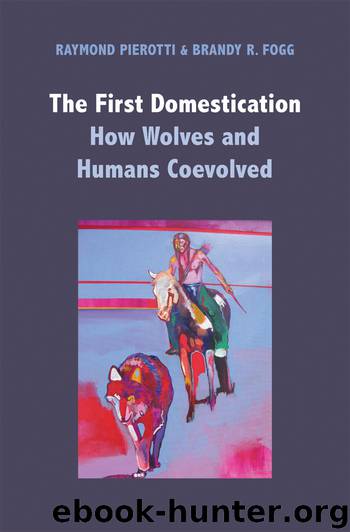The First Domestication: How Wolves and Humans Coevolved by Raymond Pierotti & Brandy R. Fogg

Author:Raymond Pierotti & Brandy R. Fogg [Pierotti, Raymond & Fogg, Brandy R.]
Language: eng
Format: epub
Tags: Nature, Animals, Mammals, Wolves, science, Life Sciences, Evolution
ISBN: 9780300226164
Google: aq88DwAAQBAJ
Amazon: 0300226160
Publisher: Yale University Press
Published: 2017-01-15T00:40:32.120000+00:00
HUMANS AS WOLF’S STUDENTS
Stories told by Indigenous American peoples about their relationships with wolves suggest that through much of the early stages of the evolution of human hunting practices, the wolf was the teacher and may have taken the lead in initiating many hunts, and thus they were not being directly manipulated by humans. Humans served as pupils in need of instruction, which casts a different light on the idea of how domestication may have proceeded, in that until recently humans were at best partners, even students, of wolves.
Marshall (1995) gives a specific account of this relationship, stating that the reason for the close relationship between wolves and the Lakota is the parallel aspects of the lives the two species share. “The people of that time learned the ways of the wolf because they understood the reality of their existence. Among them it was the hunter and the warrior who followed most closely the path of the wolf. As a hunter the wolf had no equal—with his sharp sense of smell, keen eyesight, and powerful jaws. Those were formidable weapons, but the first peoples saw that they were of little use without endurance, patience, and perseverance. They were even more important weapons of the wolf, and they were qualities the first peoples could develop in themselves” (6). As discussed in chapter 3, the family structure of a pack of wolves is very similar to that of a human nuclear family. These similarities are discussed in another of Marshall’s works: “The [wolf] family was led by a bloka, or ‘male,’ and a winyela or ‘female,’ labeled the ‘alpha’ by non-native observers. The bloka and winyela had a litter of young usually every year. Those young stayed after they were weaned and grew to young adulthood. So the core family was several generations of offspring, but only the bloka and winyela mated and bore young. Usually, as the offspring grew into adulthood, they went off to form their own families” (2005, 35).
As Mark Derr points out, “The fault line created in the Anglo-European world between wild and domestic . . . underlie[s] many of our assumptions and attitudes, despite having been well exposed and discounted in recent years. Until all preconceived notions are laid aside . . . we will not gain a clear understanding of the nature of the animal [dog] who fills so many different, frequently contradictory roles in quite different human societies” (2011, 85–86). The consistent pattern within all of these Indigenous stories is that the relationship between wolf and human was based upon respect and cooperation, especially in hunting, implying a complex and interesting alliance with the organisms that we refer to today as dogs. Indigenous understanding is illustrated by one Seneca storyteller describing the relationship between humans and dogs in the following way: “It is true that whenever a person loves a dog he derives great power from it. Dogs still know all we say; only they are not at liberty to speak. If you do not love a dog, he has the power to injure you with his orenda [magic]” (Schwartz 1997, 22).
Download
This site does not store any files on its server. We only index and link to content provided by other sites. Please contact the content providers to delete copyright contents if any and email us, we'll remove relevant links or contents immediately.
Sapiens: A Brief History of Humankind by Yuval Noah Harari(13038)
The Tidewater Tales by John Barth(12026)
Do No Harm Stories of Life, Death and Brain Surgery by Henry Marsh(6332)
Mastermind: How to Think Like Sherlock Holmes by Maria Konnikova(6225)
The Thirst by Nesbo Jo(5778)
Why We Sleep: Unlocking the Power of Sleep and Dreams by Matthew Walker(5637)
Sapiens by Yuval Noah Harari(4529)
Life 3.0: Being Human in the Age of Artificial Intelligence by Tegmark Max(4492)
The Longevity Diet by Valter Longo(4444)
The Rules Do Not Apply by Ariel Levy(3897)
The Immortal Life of Henrietta Lacks by Rebecca Skloot(3820)
The Body: A Guide for Occupants by Bill Bryson(3789)
Why We Sleep by Matthew Walker(3767)
Animal Frequency by Melissa Alvarez(3750)
Yoga Anatomy by Kaminoff Leslie(3696)
Barron's AP Biology by Goldberg M.S. Deborah T(3628)
The Hacking of the American Mind by Robert H. Lustig(3575)
All Creatures Great and Small by James Herriot(3506)
Yoga Anatomy by Leslie Kaminoff & Amy Matthews(3392)
